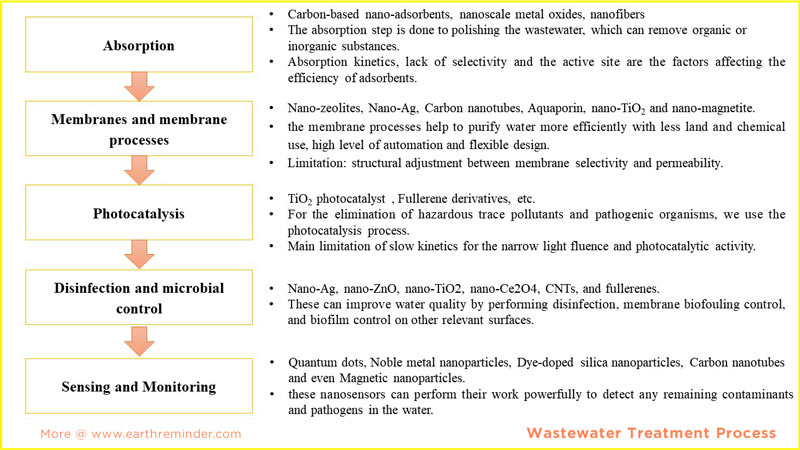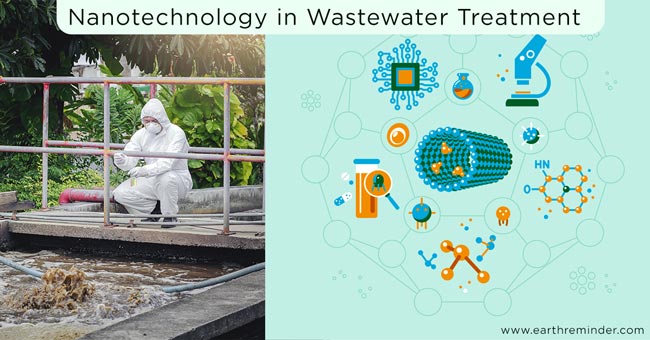Nanotechnology in Wastewater Treatment
The application of nanotechnology in wastewater treatment is the advanced innovation in which we use nanoparticles for treating the sewage or wastewater. We can also purify drinking water by wastewater treatment technology through various methods.
Water is the elixir of life and our most valuable wealth. In this modern earth, there are lots of problems, one of which is population growth. Population growth attracts some needs like civilization, urbanization, or industrialization. It thus becomes a cause of a few more serious issues like global warming, climate change, environmental pollution, and, most importantly, water-quality deterioration.
Most of our freshwater is frozen as eternal ice. Thus only 1% of freshwater is accessible for drinking purposes, and hence lots of countries are there who don’t get the facility of potable water. Therefore, 3Rs’ are the only key to save such a valuable asset. This problem gives rise to an innovation by researchers, which is a highly effective, multi-functional, and modular type of process known as wastewater nanotechnology.
Here in this chapter, we will discuss various methods of nanotechnology in wastewater treatment.
Table of Contents
What is Nanotechnology?
Before moving further, let’s understand the concept of nanotechnology. The process of nanotechnology evolved billions of years ago when the atoms combined to form molecules and originate life on earth.
The question that comes here is, “what is the combination of nanotechnology with the existence of life on earth.” From the evidence, it is cleared that life started with plants as they are the producers or autotrophs. And you will be amazed after knowing that during the process of food synthesis in plants, i.e., the Photosynthesis process, also nanotechnology is used. Food synthesis occurs in the chloroplast, the organelle having a green pigment called chlorophyll, which is essential for capturing sunlight. And chloroplast is also made up of nano stacks of thylakoids.
Another natural nanotech instance is chemical catalysis inside the body during various metabolic processes where enzymes act as catalysts. The Greek word “Nano” means dwarf, or we can consider it as tiny. One nanometre is equal to 10-9 meters.
Nowadays, nanotechnology has diverse applications and is helpful for human welfare, primarily due to the active surface area of nanoparticles.
At the end of this article, we have discussed some forms of it.
Sources and composition of wastewater
There are two broad sources of wastewater, such as residential and non-residential sources. The residential wastewater is the waste products discharged by the undigested food materials in the body and is otherwise known as sewage, which is about 99.90% diluted. Besides water, sewage also contains about 0.10% solid particles that can be classified into organic and inorganic. Organic sewage materials are carbohydrate, protein, and lipids, whereas inorganic materials include sediments, salts, and metals.
Non-residential wastewater is the waste released from commercial, industrial, and agricultural operations. Different kinds of commercial or industrial sectors are responsible for the various components of sewage. For example, textile industries mostly release dye and synthetic chemicals; however, food industries produce some oily substances and some organic food molecules. The agricultural sector has wastewater with lots of pesticides, insecticides, and fertilizers.
Wastewater Treatment Process.
The wastewater treatment process is divisible into four parts like preliminary treatment, primary treatment, secondary treatment, and tertiary or advanced treatment. You can read the entire process here – “microbes in wastewater treatment“.
This is the image describing the process of wastewater treatment in the usual way.

Application of Nanotechnology for wastewater treatment
After understanding the basics of nanotechnology and wastewater, now let’s see how nanotechnology is applied to treat wastewater.
Nanotechnology is applicable for the removal of various contaminants from the wastewater to make it pure. Nanoparticles are specific to their function, and there are no chances of remaining any contaminants after nano treatment.
Various nanoparticles involve in the nano processing of wastewater are like TiO2, ZnO, ceramic membranes, nanowire membranes, polymer membranes, carbon nanotubes, submicron nanopowder, metal (oxides), magnetic nanoparticles, nanostructure boron-doped diamond, and so on.
Applying nanotechnology in wastewater treatment is budget-friendly, and the highly specific surface area, fast dissolution, high reactivity, and strong absorption of nanoparticles leads to efficient purification of water.
Generally, the application of nanotechnology in wastewater treatment takes place through the main five steps such as;
Absorption
The first step or the absorption step is done to polishing the wastewater, which can remove organic or inorganic substances. Absorption kinetics, lack of selectivity, and the active site are the factors affecting the efficiency of adsorbents.
Carbon-based nano-adsorbents have the desirable nanomaterial properties such as high specific surface area, highly accessible adsorption sites, diverse contaminant-CNT interactions, tunable surface chemistry, and easy reuse. The carbon nanotube is utilized in contaminant preconcentration or detection, adsorption of recalcitrant contaminants.
Likewise, nanoscale metal oxides have a high specific surface area, short intraparticle diffusion distance, more adsorption sites, compressible without significant surface area reduction, and smooth reuse properties. In the absorption media filter and slurry reactors, these particles are applied.
Another representative nanomaterial is nanofibers with a core-shell structure, which enables properties like Tailored shell surface chemistry for selective adsorption, reactive core for degradation, and short internal diffusion distance. Reactive nano-adsorbents utilize nanofibers.
In slurry reactors or absorbers, nano-adsorbents can rapidly mix, which ease the process of mass transfer. Nano-adsorbents in arsenic removal are commercially used and proved to be more economical than other techniques.
Membranes and membrane processes
Membranes are the physical barriers that can separate solutes from solvents by their size. And as wastewater contains various solid materials with a different dimension, the membrane processes help to purify water more efficiently with less land and chemical use, a high level of automation, and flexible design. But here, the chief hurdle is the structural adjustment between membrane selectivity and permeability.
In the case of membranes and membrane processes, representative nanomaterials are Nano-zeolites, Nano-Ag, Carbon nanotubes, Aquaporin, nano-TiO2, and nano-magnetite.
Nano zeolites are used in High permeability thin film nanocomposite membranes as they bear properties like molecular sieve and hydrophilicity. Anti-biofouling membranes use Nano-Ag, which has intense and wide-spectrum antimicrobial activity and low toxicity to humans.
Similarly, carbon nanotubes have properties like antimicrobial activity, with small diameter, atomic smoothness of inner surface, tunable opening chemistry, and high mechanical and chemical stability. These are used in anti-biofouling membranes and aligned carbon nanotube membranes. Aquaporin has high permeability and selectivity used in aquaporin membranes.
Nano-TiO2 and nano-magnetite are Reactive membranes, high-performance thin-film nanocomposite membranes, and forward osmosis technologies, respectively. The former one is meant for photocatalytic activity, hydrophilicity, and high chemical stability, whereas nano-magnetite has tunable surface chemistry and superparamagnetic.
Photocatalysis
For the elimination of hazardous trace pollutants and pathogenic organisms, we use the photocatalysis process. It is a catalytic oxidation process having the main limitation of slow kinetics for the narrow light fluence and photocatalytic activity.
Nano-photocatalytic optimization is a process under photocatalysis that uses TiO2 for its photocatalytic activity in UV and possibly visible light range, low human toxicity, high stability, and low cost. TiO2 photocatalyst can be utilized for enhanced photocatalytic reaction kinetics and expanded photoactivity range.
Also, Fullerene derivatives having photocatalytic activity in the solar spectrum and high selectivity can be operated in Photocatalytic reactors, as well as solar disinfection systems for efficient wastewater processing.
Disinfection and microbial control
High usage of commercially available chlorine and ozone disinfectants can be toxic for organisms and its environment as they produce poisonous by-products like halogenated disinfection by-products, carcinogenic nitrosamines, bromate, etc. and UV-disinfection technique requires a high dosage of adenoviruses. Thus, an alternative, fewer disinfection by-product producing approach is developed, which takes place through the utilization of nanoparticles.
Nano-Ag, nano-ZnO, nano-TiO2, nano-Ce2O4, CNTs, and fullerenes, are the nanomaterials, which shows antimicrobial properties devoid of strong oxidation, and therefore have little ability to form DBPs. These can improve water quality by performing disinfection, membrane biofouling control, and biofilm control on other relevant surfaces.
Sensing and Monitoring
The final step includes sensing and monitoring, which is furthermore challenging. But these nanosensors can perform their work powerfully to detect any remaining contaminants and pathogens in the water. After eliminating all pollutants and pathogens; also, there are some chances of their existence, and minor neglect can quickly spread deadly diseases.
So, here in this step, some potential nano substances like quantum dots, Noble metal nanoparticles, Dye-doped silica nanoparticles, Carbon nanotubes, and even Magnetic nanoparticles are used.
These particles bear properties like Broad absorption spectrum, narrow, bright, and stable emission which scales with the particle size and chemical component, Enhanced localized surface plasmon resonances, high conductivity, High sensitivity and stability, rich silica chemistry for easy conjugation, Large surface area, high mechanical strength, and chemical stability, excellent electronic properties, and Tunable surface chemistry, superparamagnetism.
Optical detection, and electrochemical detection, Sample preconcentration, and purification are some technologies for the final step in wastewater treatment, which use the above nanoparticles.
Advantages of Nanotechnology:
There are lots of applications or advantages of nanotechnology from which few are listed below:
- It has biomedical applications like diagnosis or screening of diseases.
- Cost-effective and acts as alternative energy for the development of advanced nanotechnology driven machinery (automobiles).
- Eco-friendly as raw materials don’t produce much wastes.
- It can easily detect and eliminate pollutants from sources like air, water, or soil.
- We can also use it for the regulation of environmental problems.
- It helps to reduce its carbon footprint by reducing greenhouse gases.
Limitations of Nanotechnology:
Like various applications, there are several limitations of nanotechnology as well.
- Nanoparticles are challenging to analyze as they vary in shape and size.
- Continuance nanomaterials can harm our environment.
- Recovery and recycling rates are less.
- Lack of experienced engineers and trainers.
Conclusion
Nanotechnology is an advanced technique in this era, no doubt. However, applying nanoparticles for various purposes is not so easy as these particles need critical analysis. Further in-depth research and development are necessary for processing nanotechnology from a different perspective in life. If we correctly utilize it, it will be the most cost-effective and efficient method of dealing with environmental issues. If not, it will be hazardous for nature and human health.
In this chapter, you taught various methods of using nanotechnology for wastewater treatment. We will provide more valuable information on several other applications of nanotechnology in a different field.
References:
- “Kunduru, Konda Reddy & Nazarkovsky, Michael & Farah, Shady & Pawar, Rajendra & Basu, Arijit & Domb, Abraham. (2017). Nanotechnology for water purification: Applications of nanotechnology methods in wastewater treatment. 10.1016/B978-0-12-804300-4.00002-2.” Link here.
- What is the economic advantage of usage nanotechnology in water and waste water treatment? “PDF” – By Piyush_Kumar88
